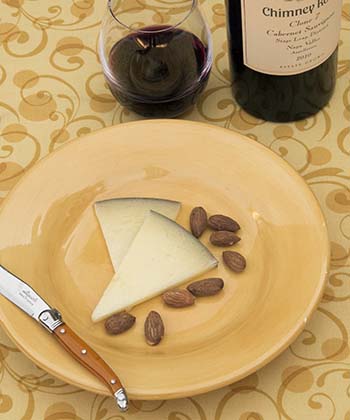For years I ignored Fiore sardo, the Sardinian sheep’s milk cheese, because I considered it too salty, smoky and sharp. Then, this past summer, I went to Sardinia, where you can’t ignore it.
This lovely Italian island has more sheep than people—the numbers aren’t even close—and sheep cheese is a dietary staple. Cheesemakers here produce several types, but Fiore sardo seems to resonate most deeply with the locals. Although tourists come for the beaches, Sardinians are historically mountain folk, and Fiore sardo reminds them of the cheese their grandfathers made. It’s one of the island’s three PDO (protected designation of origin) cheeses, along with pecorino romano and pecorino sardo, and the one that most closely respects traditional methods.
Fiore sardo must be made with raw milk from the native sheep (the Sarda breed) and lamb or goat rennet. The regulations for pecorino sardo, by comparison, allow for heat-treated milk and call for veal rennet, which yields a sweeter, less peppery cheese. In the old days, a cheesemaker could make rennet on the farm from the farm animals, but that’s no longer permitted in the interest of food safety.
Fiore sardo has changed in other ways, too. “In the past, Fiore sardo was too smoky and salty,” cheesemaker Giovanni Agostino Curreli told me when I visited his creamery, Azienda Erkiles, near Gavoi. Traditionally, Sardinia’s cheesemakers brined the wheels for 48 hours and smoked them for four days—techniques designed to preserve the cheese in the days before refrigeration. Modern producers like Curreli have dramatically reduced both the salting and smoking to make a more palatable cheese. Curreli smokes his wheels for only four to five hours.
Although I tasted some old-school Fiore sardo in Sardinia, I like the new wave better. I have purchased the cheese several times in California since returning home and have really enjoyed snacking on it and grating it on pasta (see recipe below). Purists may call it emasculated, but I call it approachable.
The Fiore sardo I’ve been purchasing has a black coating on the rind (food-grade but not meant for consumption). Wheels are flat on top and bottom but with rounded sides that the Sardinians call schiena di mulo (mule’s back). The texture is firm and dry but not sandy—just how dry will vary with age. When I break a piece in two, I get just a hint of smoke, a pleasant lamb-chop scent and a whiff of lemon. The salt is right where I like it.
Look for Fiore sardo at Artisan Cheese Gallery (Studio City); Berkeley Bowl West; Dean & DeLuca (St. Helena); Monsieur Marcel (Los Angeles); Petaluma Market; Residual Sugar (Walnut Creek); and Surfas (Culver City and Costa Mesa). Sardinians would probably drink a Cannonau with Fiore sardo—Argiolas is a reliable producer—but a big California red wine, like a Cabernet Sauvignon, works as well.


